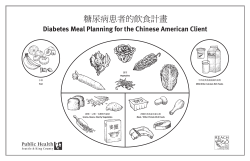
Whole Hearted Foods
Whole Hearted Foods Simple Food Choices to Benefit Heart Health Call-in #: 424-336-2000 [CA, Redondo Beach] Presented by: Edith Clogg, RD HealthWaves Program Coordinator & Dietitian 703-949-2000 [VA, Herndon] 410-649-3000 [MD, Baltimore] Participant Code: 41488983 Overview • Fats in Your Diet – Heart Healthy Fats vs. “Bad Fats” – Omega 3’s & 6’s • Fiber • Antioxidants: Color Coded Produce • Electrolytes – Role of Sodium & Potassium • Putting it all together – How do I know something is Heart Healthy? • Meal Ideas Fats in Your Diet • Eating fats is necessary for… – Healthy skin maintenance – Regulating cholesterol metabolism – Muscle contraction – The absorption of fat soluble vitamins: • A, D, E and K – Recommendation: • < 30% of total calories should come from fat (about 33-58 grams) • < 7% (about 12 grams) should come from saturated fat Heart Healthy Fats Polyunsaturate d Fatty Acids (PUFA) Monounsaturate d Fatty Acids (MUFA) • Protects against heart disease • Lowers your risks for heart attack • Sources: • Flaxseed + Walnuts • Canola Oil + Fatty Fish (salmon, trout, mackerel, herring) • Improves blood cholesterol levels • Lowers the risk of heart disease • Sources: • Oils (olive oil, canola oil, peanut oil) • Avocado + Fish • Nuts + Nut butter + Seeds Omega 3’s & 6’s • Omega 3’s – Blood clotting & building cell membranes – Associated with protection against heart disease & stroke – Essential to eat – Food sources • Fatty fish, flaxseed oils, walnuts, green vegetables • Omega 6’s – Abundant in the Western diet – Less of a health concern vs Omega-3 fatty acids. • Ratio of Omega 6 to Omega 3’s So Which Oil… Extra Virgin Olive Oil Light Olive Oil • Low smoke point • Best for salad dressings and “off heat uses” • Higher smoke point • Good olive oil for cooking Canola Oil • Great source of Omega 3’s • High smoke point, good shelf stability Vegetable/ Corn Oil • Low in Omega 3’s • High smoke point, but could find better oil Sesame, Avocado, Peanut • All great options! Cleveland Clinic Guide to Oils “Bad” Fats Saturated Fat • Worsens blood cholesterol (increases LDL) • Promotes narrowing of the arteries • Sources include: • Animal sources (beef, lamb, skin of chicken) • Whole fat dairy products • Tropical oils (Palm, palm kernel, coconut) • Lard, shortening, or butter • Fried Foods Cholesterol • Worsens blood cholesterol (increases LDL) • Sources include: • All animal products, including dairy • Shrimp • Egg yolks “Bad” Fats Trans Fat • Sources include: • Fried foods • Pre-packaged foods (crackers, regular popcorn, peanut butter, toaster pastries) • Shortening • Partially hydrogenated oils • Check 2 things: • Trans Fat • Hydrogenated Soluble fiber: Recommendations: Dissolves in water to form a Men: 50 or younger – 38 grams, 51 or older – 30 grams gel Lowers cholesterol and glucose levels Rich sources: oats, peas, beans, apples, citrus fruits, and carrots Fiber Women: 50 or younger – 25 grams, 51 or older – 21 grams Introduction to Antioxidants • Beta- carotene – Carrots and other orange/ red fruits and vegetables • Lutein – Leafy vegetables, eggs • Lycopene – Tomatoes, watermelon • Selenium – Fish, shrimp, turkey • Vitamin A • Vitamin C • Vitamin E Color Coding Antioxidants Green Fruits and Vegetables (lettuces, green apples, Swiss chard) • Vitamin C, Calcium, Vitamin K, and Folate Red Fruits and Vegetables (red bell peppers, cranberries, cherries) • Beta-carotene, Vitamin A, and Lycopene Purple or Blue Fruits and Vegetables (figs, grapes, eggplant) • Anthocyanin, Vitamin C Yellow/ Orange Fruits and Vegetables (pumpkin, winter squashes, oranges) • High in Vitamin A and C White/ Brown Vegetables (potatoes, cauliflower, garlic, parsnips) • Vitamin C The Salt Truth: -77% found in restaurant, prepared, processed foods -Reduce eating out and processed foods -Make something you would have purchased (salad dressing, pasta sauce, take-out) Potassium: Potassium-rich foods can relaxing blood vessels which blunts the adverse effects of sodium. Genetics Like many diseases, there are genetic components Putting it All Together Include multiple of the following: – Fiber – Antioxidants & Vitamins A, C, E – Lower fat animal products – Oils not solid at room temperature – Healthful produce – Whole grains To Get You Started… • Pumpkin Oatmeal – ½ cup oatmeal – ½ cup water + ¼ cup low-fat milk – Spoonful canned pumpkin – Spoonful chopped walnuts – 1 Tbsp of ground flaxseed – Sweetener of choice Roasted Vegetable Gnocchi • Cube: 1 eggplant, 1 onion, 2 bell peppers. • Combine with minced garlic, 1 T olive oil, dash salt and roast at 425 degrees for 2025 mins • Cook 16 oz gnocchi according to package instructions • Mix gnocchi and vegetables with dash garlic powder, ½ t. red pepper flakes, ¼ c. grated parmesan, 2 T olive oil, dash salt & pepper Recipe from The Forest Feast Cookbook Barley & Herb Salad with Roasted Asparagus • Cook barley according to package directions • Roast asparagus with olive oil, salt, and pepper • Mix together – – – – – 1 ½ T fresh lemon juice + 1 tsp zest 1 Tbsp sherry vinegar 1 garlic clove, chopped or pureed ½ tsp dry mustard 6 Tbsp olive oil • Transfer cooked barley to a large bowl and toss with ½ c fresh chopped parsley and vinaigrette. Serve with roasted asparagus on top. Recipe from NYTimes.com Thank You! Questions? For follow up questions: Edith Clogg, RD Edith.Clogg@ngc.com HealthWaves Resources Courtney Kiang, RD Courtney.Kiang@ngc.com • Fitness Please contact Your Local Coordinator Assessments and for more information on Heart Check events happening this month at your Consultations campus! • One-on-One Health Coaching • Nutrition information Click here to see the Heart Check Month and consultations Screening Schedule. •Wellness on Wheels at select sites …And more! References Not to be used, reproduced or modified without permission of Interactive Health management. • http://www.nutrition.gov/ • http://www.cdc.gov/nutrition/ • http://www.hsph.harvard.edu/nutri tionsource/ • http://www.nutrition.org/ • Cleveland Clinic Oil Guide
© Copyright 2025















